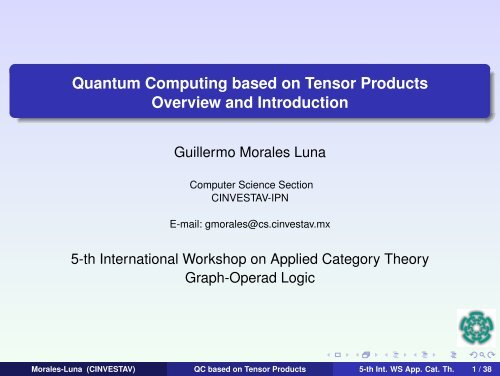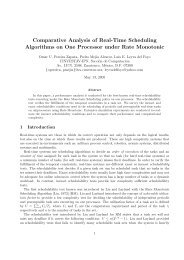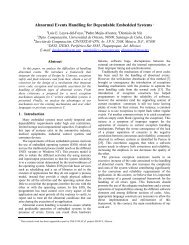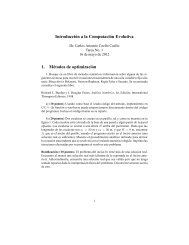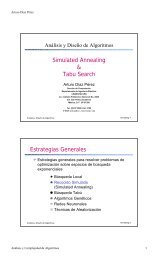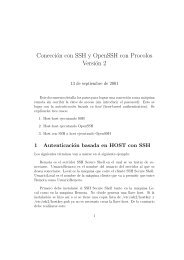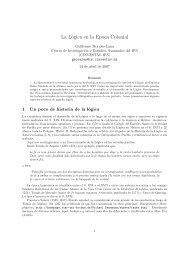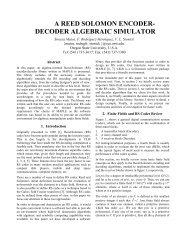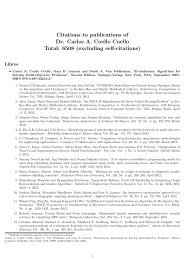Quantum Computing based on Tensor Products ... - Cinvestav
Quantum Computing based on Tensor Products ... - Cinvestav
Quantum Computing based on Tensor Products ... - Cinvestav
You also want an ePaper? Increase the reach of your titles
YUMPU automatically turns print PDFs into web optimized ePapers that Google loves.
<str<strong>on</strong>g>Quantum</str<strong>on</strong>g> <str<strong>on</strong>g>Computing</str<strong>on</strong>g> <str<strong>on</strong>g>based</str<strong>on</strong>g> <strong>on</strong> <strong>Tensor</strong> <strong>Products</strong><br />
Overview and Introducti<strong>on</strong><br />
Guillermo Morales Luna<br />
Computer Science Secti<strong>on</strong><br />
CINVESTAV-IPN<br />
E-mail: gmorales@cs.cinvestav.mx<br />
5-th Internati<strong>on</strong>al Workshop <strong>on</strong> Applied Category Theory<br />
Graph-Operad Logic<br />
Morales-Luna (CINVESTAV) QC <str<strong>on</strong>g>based</str<strong>on</strong>g> <strong>on</strong> <strong>Tensor</strong> <strong>Products</strong> 5-th Int. WS App. Cat. Th. 1 / 38
Agenda<br />
1 Abstract<br />
2 Overview of the whole course<br />
3 References<br />
4 Hilbert Spaces<br />
5 Functi<strong>on</strong> Evaluati<strong>on</strong><br />
6 Deutsch-Jozsa’s Algorithm<br />
7 <str<strong>on</strong>g>Quantum</str<strong>on</strong>g> Computati<strong>on</strong> of the Discrete Fourier Transform<br />
8 Shor Algorithm<br />
9 <str<strong>on</strong>g>Quantum</str<strong>on</strong>g> Cryptography<br />
10 Communicati<strong>on</strong> Complexity<br />
Morales-Luna (CINVESTAV) QC <str<strong>on</strong>g>based</str<strong>on</strong>g> <strong>on</strong> <strong>Tensor</strong> <strong>Products</strong> 5-th Int. WS App. Cat. Th. 2 / 38
Agenda<br />
1 Abstract<br />
2 Overview of the whole course<br />
3 References<br />
4 Hilbert Spaces<br />
5 Functi<strong>on</strong> Evaluati<strong>on</strong><br />
6 Deutsch-Jozsa’s Algorithm<br />
7 <str<strong>on</strong>g>Quantum</str<strong>on</strong>g> Computati<strong>on</strong> of the Discrete Fourier Transform<br />
8 Shor Algorithm<br />
9 <str<strong>on</strong>g>Quantum</str<strong>on</strong>g> Cryptography<br />
10 Communicati<strong>on</strong> Complexity<br />
Morales-Luna (CINVESTAV) QC <str<strong>on</strong>g>based</str<strong>on</strong>g> <strong>on</strong> <strong>Tensor</strong> <strong>Products</strong> 5-th Int. WS App. Cat. Th. 3 / 38
Abstract<br />
We present a short introducti<strong>on</strong> to <str<strong>on</strong>g>Quantum</str<strong>on</strong>g> <str<strong>on</strong>g>Computing</str<strong>on</strong>g> (QC) from a<br />
procedural point of view. Rather, it is a course of “parallel computing <str<strong>on</strong>g>based</str<strong>on</strong>g><br />
<strong>on</strong> tensor products”. We introduce primitive functi<strong>on</strong>s and the<br />
compositi<strong>on</strong>al schemes of QC. We use <strong>Tensor</strong> Product notati<strong>on</strong> instead of<br />
the more c<strong>on</strong>venti<strong>on</strong>al Dirac’s ket notati<strong>on</strong>. We introduce basic noti<strong>on</strong>s of<br />
<strong>Tensor</strong> <strong>Products</strong> and Hilbert Spaces and the qubits as points in the unit<br />
circle in the two-dimensi<strong>on</strong>al complex Hilbert space, then any word<br />
c<strong>on</strong>sisting of qubits lies in the corresp<strong>on</strong>ding unit sphere of the tensor<br />
product of these spaces. We illustrate the computing paradigm through the<br />
classical Deutsch-Josza algorithm. Then we show the quantum algorithm<br />
to compute the Discrete Fourier Transform in linear time and the famous<br />
polynomial-time Shor algorithm for integer factorizati<strong>on</strong>. We finish our<br />
expositi<strong>on</strong> with a basic introducti<strong>on</strong> to <str<strong>on</strong>g>Quantum</str<strong>on</strong>g> Cryptography and<br />
<str<strong>on</strong>g>Quantum</str<strong>on</strong>g> Communicati<strong>on</strong> Complexity.<br />
Morales-Luna (CINVESTAV) QC <str<strong>on</strong>g>based</str<strong>on</strong>g> <strong>on</strong> <strong>Tensor</strong> <strong>Products</strong> 5-th Int. WS App. Cat. Th. 4 / 38
Agenda<br />
1 Abstract<br />
2 Overview of the whole course<br />
3 References<br />
4 Hilbert Spaces<br />
5 Functi<strong>on</strong> Evaluati<strong>on</strong><br />
6 Deutsch-Jozsa’s Algorithm<br />
7 <str<strong>on</strong>g>Quantum</str<strong>on</strong>g> Computati<strong>on</strong> of the Discrete Fourier Transform<br />
8 Shor Algorithm<br />
9 <str<strong>on</strong>g>Quantum</str<strong>on</strong>g> Cryptography<br />
10 Communicati<strong>on</strong> Complexity<br />
Morales-Luna (CINVESTAV) QC <str<strong>on</strong>g>based</str<strong>on</strong>g> <strong>on</strong> <strong>Tensor</strong> <strong>Products</strong> 5-th Int. WS App. Cat. Th. 5 / 38
Overview of the whole course<br />
C<strong>on</strong>tents<br />
1 Introducti<strong>on</strong><br />
2 <strong>Tensor</strong> <strong>Products</strong><br />
1 Vector and Space <strong>Products</strong><br />
2 <strong>Products</strong> of Linear Maps<br />
3 Basic Noti<strong>on</strong>s <strong>on</strong> <str<strong>on</strong>g>Quantum</str<strong>on</strong>g> <str<strong>on</strong>g>Computing</str<strong>on</strong>g><br />
1 Measurement Principle<br />
2 Qubits and Words of <str<strong>on</strong>g>Quantum</str<strong>on</strong>g> Informati<strong>on</strong><br />
3 <str<strong>on</strong>g>Quantum</str<strong>on</strong>g> Gates<br />
4 Observables and the Heisenberg Principle of Uncertainty<br />
5 Evaluati<strong>on</strong> of Boolean Functi<strong>on</strong>s<br />
6 Deutsch-Jozsa’s Algorithm<br />
4 <str<strong>on</strong>g>Quantum</str<strong>on</strong>g> Computati<strong>on</strong> of the Discrete Fourier Transform<br />
Morales-Luna (CINVESTAV) QC <str<strong>on</strong>g>based</str<strong>on</strong>g> <strong>on</strong> <strong>Tensor</strong> <strong>Products</strong> 5-th Int. WS App. Cat. Th. 6 / 38
5 Shor Algorithm<br />
1 A Short Refreshment of Number Theory<br />
2 <str<strong>on</strong>g>Quantum</str<strong>on</strong>g> Algorithm to Calculate the Order of a Number<br />
1 Elements whose Order is a Power of 2<br />
2 Elements with Arbitrary Order<br />
6 <str<strong>on</strong>g>Quantum</str<strong>on</strong>g> Cryptography: Key Agreement Protocols<br />
1 Channels without Noise<br />
2 Channels with Noise<br />
7 Communicati<strong>on</strong> Complexity<br />
1 Parities Additi<strong>on</strong><br />
2 C<strong>on</strong>gruent Functi<strong>on</strong>s with the Hamming Weight Map<br />
3 Identity Checking<br />
4 Inner Product<br />
1 Using an Entangled Pair of Qubits<br />
2 Algorithm without Entangled States<br />
5 Deutsch-Josza Relati<strong>on</strong><br />
Morales-Luna (CINVESTAV) QC <str<strong>on</strong>g>based</str<strong>on</strong>g> <strong>on</strong> <strong>Tensor</strong> <strong>Products</strong> 5-th Int. WS App. Cat. Th. 7 / 38
Agenda<br />
1 Abstract<br />
2 Overview of the whole course<br />
3 References<br />
4 Hilbert Spaces<br />
5 Functi<strong>on</strong> Evaluati<strong>on</strong><br />
6 Deutsch-Jozsa’s Algorithm<br />
7 <str<strong>on</strong>g>Quantum</str<strong>on</strong>g> Computati<strong>on</strong> of the Discrete Fourier Transform<br />
8 Shor Algorithm<br />
9 <str<strong>on</strong>g>Quantum</str<strong>on</strong>g> Cryptography<br />
10 Communicati<strong>on</strong> Complexity<br />
Morales-Luna (CINVESTAV) QC <str<strong>on</strong>g>based</str<strong>on</strong>g> <strong>on</strong> <strong>Tensor</strong> <strong>Products</strong> 5-th Int. WS App. Cat. Th. 8 / 38
General references<br />
<str<strong>on</strong>g>Quantum</str<strong>on</strong>g> <str<strong>on</strong>g>Computing</str<strong>on</strong>g><br />
D. Bouwmeester, A. K. Ekert, and A. Zeilinger. The Physics of <str<strong>on</strong>g>Quantum</str<strong>on</strong>g><br />
Informati<strong>on</strong>: <str<strong>on</strong>g>Quantum</str<strong>on</strong>g> Cryptography, <str<strong>on</strong>g>Quantum</str<strong>on</strong>g> Teleportati<strong>on</strong>, <str<strong>on</strong>g>Quantum</str<strong>on</strong>g><br />
Computati<strong>on</strong>. Springer, Berlin, 2000.<br />
G. Brassard. <str<strong>on</strong>g>Quantum</str<strong>on</strong>g> communicati<strong>on</strong> complexity (a survey), 2001.<br />
G. Brassard, I. Chuang, S. Lloyds, and C. M<strong>on</strong>roe. <str<strong>on</strong>g>Quantum</str<strong>on</strong>g> computing.<br />
Proc. Natl. Acad. Sci. USA, 95:11032–11033, Sept. 1998.<br />
M. Nielsen and I. Chuang. <str<strong>on</strong>g>Quantum</str<strong>on</strong>g> Computati<strong>on</strong> and <str<strong>on</strong>g>Quantum</str<strong>on</strong>g> Informati<strong>on</strong>.<br />
Cambridge University Press, Cambridge, 2000.<br />
Physics and Math<br />
R. Abraham, J. E. Marsden, and T. Ratiu. Manifolds, <strong>Tensor</strong> Analysis, and<br />
Applicati<strong>on</strong>s. Springer-Verlag, Berlin, 1998.<br />
J. S. Bell. On the Einstein-Podolsky-Rosen paradox. Physics, 1:195, 1964.<br />
S. Lang. Algebra, 4-th Editi<strong>on</strong>. Springer-Verlag, Berlin, 2004.<br />
Morales-Luna (CINVESTAV) QC <str<strong>on</strong>g>based</str<strong>on</strong>g> <strong>on</strong> <strong>Tensor</strong> <strong>Products</strong> 5-th Int. WS App. Cat. Th. 9 / 38
Special topics<br />
Classics<br />
D. Deutsch. <str<strong>on</strong>g>Quantum</str<strong>on</strong>g> Theory, the Church-Turing Principle and the Universal<br />
<str<strong>on</strong>g>Quantum</str<strong>on</strong>g> Computer. Proceedings of the Royal Society of L<strong>on</strong>d<strong>on</strong> Ser. A,<br />
400:96–117, 1985.<br />
D. Deutsch and R. Jozsa. Rapid soluti<strong>on</strong> of problems by quantum<br />
computati<strong>on</strong>. Proceedings of the Royal Society of L<strong>on</strong>d<strong>on</strong> Ser. A,<br />
439:553–558, 1992.<br />
A. S. Holevo. Some estimates of the informati<strong>on</strong> transmitted by a quantum<br />
communicati<strong>on</strong> channel. Probl. Peredachi Inf., 9:3, 1973. Also Probl. Inf.<br />
Transm. (USSR) 9, 177 (1973).<br />
P. W. Shor. Algorithms for quantum computati<strong>on</strong>: Discrete logarithms and<br />
factoring. In IEEE Symposium <strong>on</strong> Foundati<strong>on</strong>s of Computer Science, pages<br />
124–134. IEEE, 1994.<br />
P. W. Shor. Polynomial-Time Algorithms for Prime Factorizati<strong>on</strong> and Discrete<br />
Logarithms <strong>on</strong> a <str<strong>on</strong>g>Quantum</str<strong>on</strong>g> Computer. SIAM Journal <strong>on</strong> <str<strong>on</strong>g>Computing</str<strong>on</strong>g>,<br />
26:1484–1509, 1997.<br />
Morales-Luna (CINVESTAV) QC <str<strong>on</strong>g>based</str<strong>on</strong>g> <strong>on</strong> <strong>Tensor</strong> <strong>Products</strong> 5-th Int. WS App. Cat. Th. 10 / 38
Algorithmics and Crypto<br />
T. Hogg. Solving highly c<strong>on</strong>strained search problems with quantum<br />
computers. Journal of Artificial Intelligence Research, 10:39–66, 1999.<br />
C. Lavor, L. Manssur, and R. Portugal. Shor’s algorithm for factoring large<br />
integers. Mar. 2003.<br />
S. J. Lom<strong>on</strong>aco. A Quick Glance at <str<strong>on</strong>g>Quantum</str<strong>on</strong>g> Cryptography. Cryptologia,<br />
23:1–41, 1999.<br />
S. J. Lom<strong>on</strong>aco. A Talk <strong>on</strong> <str<strong>on</strong>g>Quantum</str<strong>on</strong>g> Cryptography or How Alice Outwits Eve.<br />
arXiv: quant-ph/0102016v1, 2001.<br />
Morales-Luna (CINVESTAV) QC <str<strong>on</strong>g>based</str<strong>on</strong>g> <strong>on</strong> <strong>Tensor</strong> <strong>Products</strong> 5-th Int. WS App. Cat. Th. 11 / 38
<str<strong>on</strong>g>Quantum</str<strong>on</strong>g> complexity<br />
E. Bernstein and U. Vasirani. <str<strong>on</strong>g>Quantum</str<strong>on</strong>g> complexity theory. In Proc. of the<br />
25-th Annual ACM Symposium <strong>on</strong> Theory of <str<strong>on</strong>g>Computing</str<strong>on</strong>g>, AIP C<strong>on</strong>ference<br />
Proceedings. Associati<strong>on</strong> of <str<strong>on</strong>g>Computing</str<strong>on</strong>g> Machinery, 1993.<br />
R. Cleve. An introducti<strong>on</strong> to quantum complexity theory, 1999.<br />
Entanglement<br />
G. Brassard, R. Cleve, and A. Tapp. Cost of exactly simulating quantum<br />
entanglement with classical communicati<strong>on</strong>. Phys. Rev. Lett., 83:1874–1877,<br />
1999.<br />
H. Buhrman, R. Cleve, and W. van Dam. <str<strong>on</strong>g>Quantum</str<strong>on</strong>g> entanglement and<br />
communicati<strong>on</strong> complexity. SIAM J. Comp., 30(6):1829–1841, March 2001.<br />
S. Massar, D. Bac<strong>on</strong>, N. Cerf, and R. Cleve. Classical simulati<strong>on</strong> of quantum<br />
entanglement without local hidden variables. Phys. Rev. A, 63:52305, 2001.<br />
Morales-Luna (CINVESTAV) QC <str<strong>on</strong>g>based</str<strong>on</strong>g> <strong>on</strong> <strong>Tensor</strong> <strong>Products</strong> 5-th Int. WS App. Cat. Th. 12 / 38
Agenda<br />
1 Abstract<br />
2 Overview of the whole course<br />
3 References<br />
4 Hilbert Spaces<br />
5 Functi<strong>on</strong> Evaluati<strong>on</strong><br />
6 Deutsch-Jozsa’s Algorithm<br />
7 <str<strong>on</strong>g>Quantum</str<strong>on</strong>g> Computati<strong>on</strong> of the Discrete Fourier Transform<br />
8 Shor Algorithm<br />
9 <str<strong>on</strong>g>Quantum</str<strong>on</strong>g> Cryptography<br />
10 Communicati<strong>on</strong> Complexity<br />
Morales-Luna (CINVESTAV) QC <str<strong>on</strong>g>based</str<strong>on</strong>g> <strong>on</strong> <strong>Tensor</strong> <strong>Products</strong> 5-th Int. WS App. Cat. Th. 13 / 38
Hilbert Spaces<br />
Basic noti<strong>on</strong>s<br />
Complex field. C<br />
Vector space. H: N<strong>on</strong>-empty set. 0 ∈ H<br />
Additi<strong>on</strong>. + : H × H → H. (H, +) Abelian group<br />
Scalar multiplicati<strong>on</strong>. · : C × H → H. Distributive w.r.t. additi<strong>on</strong><br />
Inner product. 〈·|·〉 : H × H → C. Sesquilinear form. Positive definite.<br />
Norm. � · �2 : H → R + , x ↦→ � · �2 = √ 〈x|x〉.<br />
Completeness. Every Cauchy sequence is c<strong>on</strong>vergent.<br />
Autoduality. For each T ∈ H ∗ exists y ∈ H: T(x) = 〈y|x〉.<br />
Morales-Luna (CINVESTAV) QC <str<strong>on</strong>g>based</str<strong>on</strong>g> <strong>on</strong> <strong>Tensor</strong> <strong>Products</strong> 5-th Int. WS App. Cat. Th. 14 / 38
Geometrical properties: m-dimensi<strong>on</strong>al Hilbert spaces<br />
Can<strong>on</strong>ical basis. ej = (δij) i
Measurement Principle<br />
In current state<br />
v = (vi1) i
Qubits and Quregisters<br />
Spaces and basis<br />
H1 = C 2 ; Hn = Hn−1 ⊗ H1<br />
dim(Hn) = 2 n<br />
e0 = [1 0] T and e1 = [0 1] T basis in H1.<br />
(eεn−1···ε1ε0 ) εn−1,...,ε1,ε0∈{0,1}<br />
basis in Hn.<br />
Qubits. z ∈ E2 unit sphere in H1.<br />
Quregister. z1 ⊗ · · · ⊗ zn−1 ⇐= zi, i ∈ N, qubits<br />
z1 ⊗ · · · ⊗ zn−1 ∈ E2n ⊂ Hn<br />
Morales-Luna (CINVESTAV) QC <str<strong>on</strong>g>based</str<strong>on</strong>g> <strong>on</strong> <strong>Tensor</strong> <strong>Products</strong> 5-th Int. WS App. Cat. Th. 17 / 38
<str<strong>on</strong>g>Quantum</str<strong>on</strong>g> speed-up<br />
C<strong>on</strong>venti<strong>on</strong>al Dirac’s “ket” notati<strong>on</strong><br />
|εn−1 · · · ε1ε0〉 := eεn−1···ε1ε0<br />
= eεn−1 ⊗ · · · ⊗ eε1 ⊗ eε0<br />
=: |εn−1〉 · · · |ε1〉 |ε0〉 (1)<br />
Any state in Hn, σ(z) = � ε∈{0,1} n zεeε is determined by 2 n coordinates. If<br />
U : Hn → Hn is a quantum operator, the target state σ(Uz) c<strong>on</strong>sists also<br />
of 2 n coordinates.<br />
A calculus involving an exp<strong>on</strong>ential number of terms is performed in just<br />
“<strong>on</strong>e step” of the quantum computati<strong>on</strong>.<br />
Morales-Luna (CINVESTAV) QC <str<strong>on</strong>g>based</str<strong>on</strong>g> <strong>on</strong> <strong>Tensor</strong> <strong>Products</strong> 5-th Int. WS App. Cat. Th. 18 / 38
Agenda<br />
1 Abstract<br />
2 Overview of the whole course<br />
3 References<br />
4 Hilbert Spaces<br />
5 Functi<strong>on</strong> Evaluati<strong>on</strong><br />
6 Deutsch-Jozsa’s Algorithm<br />
7 <str<strong>on</strong>g>Quantum</str<strong>on</strong>g> Computati<strong>on</strong> of the Discrete Fourier Transform<br />
8 Shor Algorithm<br />
9 <str<strong>on</strong>g>Quantum</str<strong>on</strong>g> Cryptography<br />
10 Communicati<strong>on</strong> Complexity<br />
Morales-Luna (CINVESTAV) QC <str<strong>on</strong>g>based</str<strong>on</strong>g> <strong>on</strong> <strong>Tensor</strong> <strong>Products</strong> 5-th Int. WS App. Cat. Th. 19 / 38
Functi<strong>on</strong> Evaluati<strong>on</strong><br />
V = {0, 1}: binary digits<br />
Each index in the set {0, . . . , 2 n − 1} corresp<strong>on</strong>ds to a string<br />
ε = (εn−1, . . . , ε1, ε0) ∈ V n which in turn corresp<strong>on</strong>ds to eε ∈ Hn.<br />
Let f : V n → V m be a functi<strong>on</strong>.<br />
A quantum algorithm Uf : Hn+m → Hn+m computes f if<br />
Uf : eε ⊗ 0 ↦→ eε ⊗ ɛe f(ε)<br />
where |ɛ| = 1. A final measurement <strong>on</strong> last qubits provides the value f(ε),<br />
with probability 1.<br />
Morales-Luna (CINVESTAV) QC <str<strong>on</strong>g>based</str<strong>on</strong>g> <strong>on</strong> <strong>Tensor</strong> <strong>Products</strong> 5-th Int. WS App. Cat. Th. 20 / 38
Agenda<br />
1 Abstract<br />
2 Overview of the whole course<br />
3 References<br />
4 Hilbert Spaces<br />
5 Functi<strong>on</strong> Evaluati<strong>on</strong><br />
6 Deutsch-Jozsa’s Algorithm<br />
7 <str<strong>on</strong>g>Quantum</str<strong>on</strong>g> Computati<strong>on</strong> of the Discrete Fourier Transform<br />
8 Shor Algorithm<br />
9 <str<strong>on</strong>g>Quantum</str<strong>on</strong>g> Cryptography<br />
10 Communicati<strong>on</strong> Complexity<br />
Morales-Luna (CINVESTAV) QC <str<strong>on</strong>g>based</str<strong>on</strong>g> <strong>on</strong> <strong>Tensor</strong> <strong>Products</strong> 5-th Int. WS App. Cat. Th. 21 / 38
Deutsch-Jozsa’s Algorithm<br />
Let V = {0, 1} be the set of classical truth values.<br />
Deutsch-Jozsa’s problem<br />
Decide, for a given f : V → V, whether it is c<strong>on</strong>stant or balanced “in just<br />
<strong>on</strong>e computing step”.<br />
Given f, let Uf be the 2 2 × 2 2 -matrix s.t. Uf(ex ⊗ ez) = (ex ⊗ e (z+f(x)) mod 2).<br />
We have H2Uf H2 : e0 ⊗ e1 ↦→ εeS ⊗ e1<br />
where H2 is Hadamard’s operator, ε ∈ {−1, 1} is a sign and S is a signal<br />
indicating whether f is balanced or not.<br />
S coincides with f(0) ⊕ f(1).<br />
Morales-Luna (CINVESTAV) QC <str<strong>on</strong>g>based</str<strong>on</strong>g> <strong>on</strong> <strong>Tensor</strong> <strong>Products</strong> 5-th Int. WS App. Cat. Th. 22 / 38
Agenda<br />
1 Abstract<br />
2 Overview of the whole course<br />
3 References<br />
4 Hilbert Spaces<br />
5 Functi<strong>on</strong> Evaluati<strong>on</strong><br />
6 Deutsch-Jozsa’s Algorithm<br />
7 <str<strong>on</strong>g>Quantum</str<strong>on</strong>g> Computati<strong>on</strong> of the Discrete Fourier Transform<br />
8 Shor Algorithm<br />
9 <str<strong>on</strong>g>Quantum</str<strong>on</strong>g> Cryptography<br />
10 Communicati<strong>on</strong> Complexity<br />
Morales-Luna (CINVESTAV) QC <str<strong>on</strong>g>based</str<strong>on</strong>g> <strong>on</strong> <strong>Tensor</strong> <strong>Products</strong> 5-th Int. WS App. Cat. Th. 23 / 38
<str<strong>on</strong>g>Quantum</str<strong>on</strong>g> Computati<strong>on</strong> of the Discrete Fourier Transform<br />
Given f = � n−1<br />
j=0 f(j)ej ∈ C n , its discrete Fourier transform is<br />
DFT(f) = ˆ ⎡<br />
�n−1<br />
1 �n−1<br />
� � ⎤<br />
2πijk<br />
f = ⎢⎣ √ exp f(k) ⎥⎦<br />
n<br />
n<br />
ej ∈ C n .<br />
j=0<br />
k=0<br />
DFT is linear transform and, w.r.t. � �the can<strong>on</strong>ical �� basis, it is represented by<br />
2πijk<br />
exp n<br />
the unitary matrix DFT = 1 √ n<br />
Morales-Luna (CINVESTAV) QC <str<strong>on</strong>g>based</str<strong>on</strong>g> <strong>on</strong> <strong>Tensor</strong> <strong>Products</strong> 5-th Int. WS App. Cat. Th. 24 / 38<br />
jk
If n = 2 ν , Hν = C n , and by identifying each j ∈ [[0, 2 ν − 1]] with<br />
εj = εj,ν−1 · · · εj,1εj,0:<br />
DFT(eεj ) =<br />
�ν−1<br />
�<br />
1<br />
√ e0 + exp<br />
2<br />
� �<br />
πij<br />
2 k<br />
e1<br />
k=0<br />
= 1 � �<br />
πij<br />
√ e0+exp<br />
2<br />
20 � �<br />
e1 ⊗ 1 � �<br />
πij<br />
√ e0+exp<br />
2<br />
21 � �<br />
e1 ⊗···⊗ 1 √<br />
2<br />
�<br />
� �<br />
πij<br />
e0+exp<br />
2ν−1 � �<br />
e1<br />
The products appearing in this tensor product suggest the operators<br />
Qk : H1 → H1 and their “c<strong>on</strong>trolled” versi<strong>on</strong>s:<br />
Qk =<br />
⎡<br />
⎢⎣<br />
1 0<br />
0 exp � πi<br />
2k �<br />
⎤<br />
⎥⎦ , Q c<br />
kj =<br />
⎡<br />
⎢⎣<br />
1 0<br />
0 exp � πi<br />
Morales-Luna (CINVESTAV) QC <str<strong>on</strong>g>based</str<strong>on</strong>g> <strong>on</strong> <strong>Tensor</strong> <strong>Products</strong> 5-th Int. WS App. Cat. Th. 25 / 38<br />
j<br />
2k �<br />
⎤<br />
⎥⎦ .<br />
(2)
Algorithm for the Fourier transform<br />
Input. n = 2 ν , f ∈ C n = Hν.<br />
Output. ˆ f = DFT(f) ∈ Hν.<br />
Procedure DFT(n, f)<br />
1 Let x0 := H(e0).<br />
2 For each j ∈ [[0, 2 ν − 1]], or equivalently, for each<br />
(εj,ν−1 · · · εj,1εj,0) ∈ {0, 1} ν , do (in parallel):<br />
1 For each k ∈ [[0, ν − 1]] do (in parallel):<br />
� �<br />
1 Let δ :=<br />
�<br />
�<br />
Rk εj be the reverse of the chain c<strong>on</strong>sisting of<br />
�<br />
k<br />
the (k + 1) less significant bits.<br />
2 Let yjk := x0.<br />
3 For ℓ = 0 to k do { yjk := Q c2 (yjk , eδ ) } j,ℓ<br />
2 Let y j := y j0 ⊗ · · · ⊗ y j,ν−1 .<br />
3 Output as result ˆ f = � 2 ν −1<br />
j=0 fjy j .<br />
Morales-Luna (CINVESTAV) QC <str<strong>on</strong>g>based</str<strong>on</strong>g> <strong>on</strong> <strong>Tensor</strong> <strong>Products</strong> 5-th Int. WS App. Cat. Th. 26 / 38
Agenda<br />
1 Abstract<br />
2 Overview of the whole course<br />
3 References<br />
4 Hilbert Spaces<br />
5 Functi<strong>on</strong> Evaluati<strong>on</strong><br />
6 Deutsch-Jozsa’s Algorithm<br />
7 <str<strong>on</strong>g>Quantum</str<strong>on</strong>g> Computati<strong>on</strong> of the Discrete Fourier Transform<br />
8 Shor Algorithm<br />
9 <str<strong>on</strong>g>Quantum</str<strong>on</strong>g> Cryptography<br />
10 Communicati<strong>on</strong> Complexity<br />
Morales-Luna (CINVESTAV) QC <str<strong>on</strong>g>based</str<strong>on</strong>g> <strong>on</strong> <strong>Tensor</strong> <strong>Products</strong> 5-th Int. WS App. Cat. Th. 27 / 38
Let n be an integer to be factored<br />
1 Select an integer m such that 1 < m < n.<br />
2 If gcd(n, m) = d > 1, then d is a n<strong>on</strong>-trivial factor of n.<br />
3 Otherwise, m is in the multiplicative group of remainders of n.<br />
1 If m has an even order r, then k = m r<br />
2 will be such that k 2 = 1 mod n,<br />
and (k − 1)(k + 1) = 0 mod n.<br />
2 By calculating gcd(n, k − 1) and gcd(n, k + 1), <strong>on</strong>e gets n<strong>on</strong>-trivial<br />
factors of n.<br />
Morales-Luna (CINVESTAV) QC <str<strong>on</strong>g>based</str<strong>on</strong>g> <strong>on</strong> <strong>Tensor</strong> <strong>Products</strong> 5-th Int. WS App. Cat. Th. 28 / 38
Biggest problem<br />
Calculate the order of a current element m in Φ(n)<br />
Let ν = ⌈log 2 n⌉, ν is the size of n.<br />
O(n) = O(2 ν ), thus an exhaustive procedure has exp<strong>on</strong>ential complexity<br />
with respect to the input size. Shor’s algorithm is <str<strong>on</strong>g>based</str<strong>on</strong>g> over a<br />
polynomial-time procedure in ν to calculate the order of an element.<br />
Morales-Luna (CINVESTAV) QC <str<strong>on</strong>g>based</str<strong>on</strong>g> <strong>on</strong> <strong>Tensor</strong> <strong>Products</strong> 5-th Int. WS App. Cat. Th. 29 / 38
Agenda<br />
1 Abstract<br />
2 Overview of the whole course<br />
3 References<br />
4 Hilbert Spaces<br />
5 Functi<strong>on</strong> Evaluati<strong>on</strong><br />
6 Deutsch-Jozsa’s Algorithm<br />
7 <str<strong>on</strong>g>Quantum</str<strong>on</strong>g> Computati<strong>on</strong> of the Discrete Fourier Transform<br />
8 Shor Algorithm<br />
9 <str<strong>on</strong>g>Quantum</str<strong>on</strong>g> Cryptography<br />
10 Communicati<strong>on</strong> Complexity<br />
Morales-Luna (CINVESTAV) QC <str<strong>on</strong>g>based</str<strong>on</strong>g> <strong>on</strong> <strong>Tensor</strong> <strong>Products</strong> 5-th Int. WS App. Cat. Th. 30 / 38
<str<strong>on</strong>g>Quantum</str<strong>on</strong>g> Cryptography: Key Agreement Protocols<br />
Two entities, Alice and Bob, should agree in private a comm<strong>on</strong> key.<br />
They may use two transmissi<strong>on</strong> channels<br />
<str<strong>on</strong>g>Quantum</str<strong>on</strong>g> channel Transmits just <strong>on</strong>e-way, say from Alice to Bob.<br />
Classical channel Transmits bidirecti<strong>on</strong>ally.<br />
We will present the BB84 Protocol, without and with noise.<br />
Morales-Luna (CINVESTAV) QC <str<strong>on</strong>g>based</str<strong>on</strong>g> <strong>on</strong> <strong>Tensor</strong> <strong>Products</strong> 5-th Int. WS App. Cat. Th. 31 / 38
<str<strong>on</strong>g>Quantum</str<strong>on</strong>g> computing elements<br />
E0 = {e0 = (1, 0), e0 = (0, 1)}: can<strong>on</strong>ical basis of H1<br />
0 1<br />
H(E 0 ) = E1 = {e1, e1<br />
0 1 }: basis of H1 obtained by applying Hadamard’s<br />
operator to E0 .<br />
E0 corresp<strong>on</strong>ds to a spin with vertical–horiz<strong>on</strong>tal polarizati<strong>on</strong>, E0 = {↑, →},<br />
while<br />
E1 corresp<strong>on</strong>ds to a spin with oblique or NW–NE polarizati<strong>on</strong>,<br />
E1 = {↖, ↗}.<br />
The same sequence of qubits can be measured either w.r.t. to E0 or E1 .<br />
An eavesdropper can be detected quite directly!<br />
This is characteristic of <str<strong>on</strong>g>Quantum</str<strong>on</strong>g> Cryptography.<br />
Morales-Luna (CINVESTAV) QC <str<strong>on</strong>g>based</str<strong>on</strong>g> <strong>on</strong> <strong>Tensor</strong> <strong>Products</strong> 5-th Int. WS App. Cat. Th. 32 / 38
Agenda<br />
1 Abstract<br />
2 Overview of the whole course<br />
3 References<br />
4 Hilbert Spaces<br />
5 Functi<strong>on</strong> Evaluati<strong>on</strong><br />
6 Deutsch-Jozsa’s Algorithm<br />
7 <str<strong>on</strong>g>Quantum</str<strong>on</strong>g> Computati<strong>on</strong> of the Discrete Fourier Transform<br />
8 Shor Algorithm<br />
9 <str<strong>on</strong>g>Quantum</str<strong>on</strong>g> Cryptography<br />
10 Communicati<strong>on</strong> Complexity<br />
Morales-Luna (CINVESTAV) QC <str<strong>on</strong>g>based</str<strong>on</strong>g> <strong>on</strong> <strong>Tensor</strong> <strong>Products</strong> 5-th Int. WS App. Cat. Th. 33 / 38
Communicati<strong>on</strong> Complexity<br />
The complexity of a communicati<strong>on</strong> process is determined by the minimum<br />
informati<strong>on</strong> quantity that should be transmitted, in order that the total<br />
informati<strong>on</strong> can be recovered by the receiving part, within a given c<strong>on</strong>text.<br />
Optimal Transmissi<strong>on</strong><br />
Let us assume that three sets X, Y, Z are given and a functi<strong>on</strong><br />
f : X × Y → Z. At some moment, Alice, who is a communicating part,<br />
possesses a point x ∈ X, Bob, who is a sec<strong>on</strong>d part, possesses a point<br />
y ∈ Y and both parts should calculate z = f(x, y), by interchanging the<br />
minimum informati<strong>on</strong> quantity.<br />
Morales-Luna (CINVESTAV) QC <str<strong>on</strong>g>based</str<strong>on</strong>g> <strong>on</strong> <strong>Tensor</strong> <strong>Products</strong> 5-th Int. WS App. Cat. Th. 34 / 38
Identity Checking<br />
Exact and obvious method<br />
If f : (x, y) ↦→ χ=(x, y) is the characteristic functi<strong>on</strong> of the identity relati<strong>on</strong>:<br />
f(x, y) = 1 if and <strong>on</strong>ly if x = y,<br />
then Alice and Bob should interchange n bits to calculate f(x, y).<br />
n is exp<strong>on</strong>ential with respect to its size!<br />
Morales-Luna (CINVESTAV) QC <str<strong>on</strong>g>based</str<strong>on</strong>g> <strong>on</strong> <strong>Tensor</strong> <strong>Products</strong> 5-th Int. WS App. Cat. Th. 35 / 38
An interesting questi<strong>on</strong> is whether an exact algorithm can be obtained with<br />
logarithmic complexity.<br />
The following theorem excludes the possibility to communicate more than<br />
k (classical) bits of informati<strong>on</strong> by transmitting k qubits.<br />
Holevo’s Theorem<br />
The informati<strong>on</strong> quantity recovered from a register of qubits is upperly<br />
bounded by the value of v<strong>on</strong> Neumann’s entropy, which is bounded by<br />
Shann<strong>on</strong>’s entropy. Both entropies coincide whenever the qubits are<br />
pairwise orthog<strong>on</strong>al.<br />
However, in <str<strong>on</strong>g>Quantum</str<strong>on</strong>g> <str<strong>on</strong>g>Computing</str<strong>on</strong>g> the use of the noti<strong>on</strong> of entangled states<br />
improves the communicati<strong>on</strong> complexities of several procedures.<br />
Morales-Luna (CINVESTAV) QC <str<strong>on</strong>g>based</str<strong>on</strong>g> <strong>on</strong> <strong>Tensor</strong> <strong>Products</strong> 5-th Int. WS App. Cat. Th. 36 / 38
Deutsch-Josza Relati<strong>on</strong><br />
Pseudotelepathy Game<br />
Given four sets X, Y, A and B, a relati<strong>on</strong> R ⊂ X × and × A × B, and the<br />
fact that Alice and Bob are separated, far from each other, at a given<br />
moment Alice receives a point x ∈ X, Bob a y ∈ Y and they, trying to<br />
interchange the minimum informati<strong>on</strong>, should produce, respectively, a ∈ A<br />
and b ∈ B such that (x, y, a, b) ∈ R.<br />
Morales-Luna (CINVESTAV) QC <str<strong>on</strong>g>based</str<strong>on</strong>g> <strong>on</strong> <strong>Tensor</strong> <strong>Products</strong> 5-th Int. WS App. Cat. Th. 37 / 38
In particular, for n = 2 k a power of 2, X = {0, 1} n = Y, A = {0, 1} k = B<br />
R is Deutsch-Josza relati<strong>on</strong><br />
(x, y, a, b) ∈ R ⇔<br />
�<br />
(Hn(x, y) = 0 ∧ a = b) ∨<br />
�<br />
Hn(x, y) � 0, n<br />
��<br />
2<br />
�<br />
Hn(x, y) = n<br />
2<br />
�<br />
∧ a � b<br />
If the points x and y of Alice and Bob coincide, then the sequences<br />
that they produce should coincide<br />
If x and y differ exactly in half of the bits, then the produced<br />
sequences should differ<br />
In any other case no restricti<strong>on</strong>s <strong>on</strong> produced sequences<br />
Morales-Luna (CINVESTAV) QC <str<strong>on</strong>g>based</str<strong>on</strong>g> <strong>on</strong> <strong>Tensor</strong> <strong>Products</strong> 5-th Int. WS App. Cat. Th. 38 / 38<br />
∨<br />
(3)


